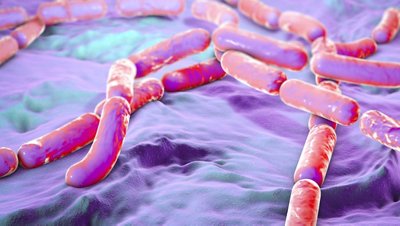Distinction of the Bacillus cereus Group Species in Routine Diagnostics
January 07, 2022

IS THE AFFILIATION OF 7 MAJOR PHYLOGENETIC GROUPS RELEVANT TO IDENTIFY MICROBIOLOGICAL HAZARD?
Short description of Bacillus cereus Group & associated industrial issues
Bacillus cereus Group, also known as presumptive Bacillus cereus or B. cereus sensu lato comprises closely related species widely distributed in the environment and food matrices. Besides characteristic colonies on MYP agar, these species exhibit highly divergent properties and their distinction remains challenging. Presently, their classification relies mainly on distinctive phenotypic traits, such as pathogenic potential to mammals (B. anthracis, B. cytotoxicus, emetic/diarrheic strains of B. cereus) and insects (B. thuringiensis), enzymatic ability causing food spoilage (B. weihenstephanesis, B. wiedmannii), thermotypes, as well as colony morphology (B. (pseudo)mycoides). Recently, 15 additional species among which Bacillus paranthracis and Bacillus toyonensis have been recognized as plausible members of this group.
At present, distinction of the B. cereus group species in routine diagnostics remains difficult, therefore exact speciation is not often done. Yet, from a food industrial perspective, the affiliation of 7 major phylogenetic groups seems relevant to identify microbiological hazard in food and along the food production chain (Table 1). Rather than species identification, hazard identification with associated phylogenetic group seems more informative to mitigate risks.
TABLE 1: SOME FEATURES ASSOCIATED TO B. CEREUS 7 MAJOR PHYLOGENETIC GROUP
| 8 | GROWTH AT 8°C 2 | HEAT RESISTANCE 1,2,6 | FOOD POISONING 2,6 | SPECIES | DIVERSITY TESTED ON ISO16140-2 VALIDATED METHODS 4 |
|---|---|---|---|---|---|
| I | - | / | _ | B. pseudomycoides | þ |
| II | + | ++ | + | B. cereus, B. albus, B. luti, B. fungorum, B. mobilis, B. nitratireducens B. proteoliticus, B. thuringiensis, B. wiedmannii | þ |
| III | - | +++ | +++ | B. anthracis, B. cereus, B. pacificus, B. paranthracis, B. thuringiensis, B. tropicus | þ |
| IV | - | ++ | ++ | B. cereus, B. thuringiensis | þ |
| V | + 5, 8 | ++ | + | B. cereus, B. thuringiensis, B. toyonensis | þ |
| VI | + | +/- | - | B. mycoides, B. clarus#, B. paramycoides, B. thuringiensis, B. weihenstephanensis | þ |
| VII | - | +++ | +++ | B. cytotoxicus | þ |
Newly described species are indicated in bold, for which no wild strain is available in DSMZ nor NCTC collections * Described strains with panC identification % below 70% while higher than 90% to be significant # not yet validly published.
One could follow this workflow to identify microbiological hazard:
Step 1: identification of presumptive B. cereus on MYP or ISO16140-2 validated chromogenic agar after bacterial count according to ISO7932
Step 2: identification of phylogenetic group on 3-5 isolates using panC sequence
(Guinebretiere et al. 2010, https://tools.symprevius.org/Bcereus/english.php)
Step 3: informative optional tests depending on the phylogenetic group obtained
Group III: distinction between emetic (ces+) and non-emetic (ces-) strains
Group IV: distinction between commercial Bt strains
Note that these organisms show a high degree of shared gene content and a high variable plasmid content which play an important role in the genomic plasticity and virulence properties. Since genes encoding for diarrheic toxin are harbored by chromosome, all strains have the potential to produce these toxins making hazard distinction limited to ces+, cytk1+ (see optional tests in ISO7932:2005/Amd1:2021).
> Read also the general article: BACILLUS CEREUS GROUP: PERSISTENT AND HARMFUL TOXIN-PRODUCING MICROORGANISMS IN THE FOOD INDUSTRY
> Download the complete Bacillus cereus group classification table (new species untill September 2021)
REFERENCES
1- Afchain AL, Carlin F, Nguyen-The C, Albert I. Improving quantitative exposure assessment by considering genetic diversity of B. cereus in cooked, pasteurised and chilled foods. Int J Food Microbiol. 2008 Nov 30;128(1):165-73. doi: 10.1016/j.ijfoodmicro.2008.07.028. Epub 2008 Aug 5. PMID: 18805600.
2- Guinebretière MH, Thompson FL, Sorokin A, Normand P, Dawyndt P, Ehling-Schulz M, et al. Ecological diversification in the Bacillus cereus Group. Environ Microbiol. 2008 ;10:851-65. [reference 16 of the Excel complete classification table]
3- Guinebretière MH, Velge P, Couvert O, Carlin F, Debuyser ML, Nguyen-The C. Ability of Bacillus cereus group strains to cause food poisoning varies according to phylogenetic affiliation (groups I to VII) rather than species affiliation. J Clin Microbiol. 2010 Sep;48(9):3388-91. doi: 10.1128/JCM.00921-10. Epub 2010 Jul 21. PMID: 20660215; PMCID: PMC2937725.
4- ISO16140-2 validation report of chromogenic media https://nf-validation.afnor.org/domaine-agroalimentaire/bacillus-cereus/
5- Le Marc Y, Buss da Silva N, Postollec F, Huchet V, Baranyi J, Ellouze M. A stochastic approach for modelling the effects of temperature on the growth rate of Bacillus cereus sensu lato. Int J Food Microbiol. 2021 Jul 2;349:109241. doi: 10.1016/j.ijfoodmicro.2021.109241. Epub 2021 May 11. PMID: 34022612.
6- Luu-Thi H, Khadka DB, Michiels CW. Thermal inactivation parameters of spores from different phylogenetic groups of Bacillus cereus. Int J Food Microbiol. 2014 Oct 17;189:183-8. doi: 10.1016/j.ijfoodmicro.2014.07.027. Epub 2014 Jul 30. PMID: 25171111.
7- Sabrina Cadel Six, Marie-Laure De Buyser, Marie-Léone Vignaud, Trinh Tam Dao, Sabine Messio, Sylvie Pairaud, Jacques-Antoine Hennekinne, Nathalie Pihier, Anne Brisabois, Toxi-infections alimentaires collectives à Bacillus cereus : bilan de la caractérisation des souches de 2006 à 2010, BHE Hors-série 9 mai 2012 | https://www.santepubliquefrance.fr/maladies-et-traumatismes/maladies-infectieuses-d-origine-alimentaire/toxi-infections-alimentaires-collectives/documents/article/toxi-infections-alimentaires-collectives-a-bacillus-cereus-bilan-de-la-caracterisation-des-souches-de-2006-a-2010. [reference 17 of the Excel complete classification table]
8- Webb MD, Barker GC, Goodburn KE, Peck MW. Risk presented to minimally processed chilled foods by psychrotrophic Bacillus cereus. Trends Food Sci Technol. 2019 Nov;93:94-105. doi: 10.1016/j.tifs.2019.08.024. PMID: 31764911; PMCID: PMC6853023.


